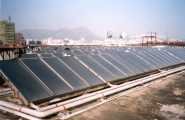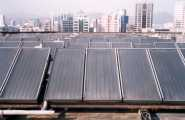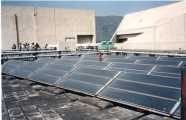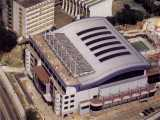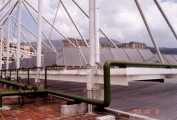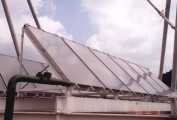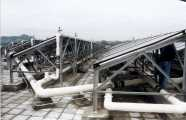非官方發佈資料 Unofficial Release
AN EXPLORATION TO A PRACTICAL
BUSINESS MODEL FOR THE APPLICATION OF SOLAR ENERGY AS A SUSTAINABLE INDUSTRY IN
HONG KONG.
June 12, 2009
PREFACEUM Blogger 網誌編輯組 June 20, 2009 The following report was originally a course assignment on creativity and innovation written by Ms P. Cheng, who is the marketing officer of our company. However, we felt that the idea conveyed in the report worth our serious consideration. It always seems that there is an internal conflict between the advertising industry and the conservation of environment because the genuine nature of of advertising is the propagation of consumption and Epicureanism. Upon her consent, we contribute this report to the general public as an unofficial release of our internal study. The mission of the report was trying to find out a solution for saving the environment without the feeling of the deterioration in the quality of life throughout the process of making changes. If anyone thinks that he or she may copy the idea and run a business in the way as the report proposed, we, including the writer, will be delighted to see his or her success and we believe that this sustainable mode of living will benefit us, especially our younger generation. In the past, we have never advocated conservation of environment as we thought that it was hypocritical for our industry to strive for playing the leading role for the reason we have just mentioned. Now we may try our best to propose a better solution to our clients in terms of the extent to which conservation of environment will be achieved . |
|
INDEX INTRODUCTION BACKGROUND GLOBAL WARMING AND ITS IMPACT ON THE WORLD SPECIFIC IMPACT OF GLOBAL WARMING ON HONG KONG AVAILABILITY OF SOLAR ENERGY AND ITS CURRENT
APPLICATION IN HONG KONG PUBLIC APPEAL TO A FUNDAMENTAL CHANGE METHODOLOGY AND GUIDING PRINCIPLE METHODOLOGY PRINCIPLE AN EXPLORATION TO A PRACTICAL BUSINESS
MODEL FOR THE APPLICATION OF SOLAR ENERGY AS A SUSTAINABLE INDUSTRY IN HONG
KONG. MISSION OBJECTIVES RATIONALE OF THE PROJECT FUNDING ORGANIZATION GROWTH AND DEVELOPMENT |
INTRODUCTION
Innovation and creativity are now claimed to be
widely applied in various field. They are especially crucial in the
initialization of a paradigm shift. Most leading companies in the world also
seek ways to maximize the profit, minimize the expenses, enlarge the market
share and reduce costs. On the other hand, more and more emphasis is put on the
social responsibility of business firms in carry out their business activities.
In order to meet the company's target, innovation and creativity are required
for a top management team.
A practical example is found in the use of
solar energy. Solar energy is an environmental friendly energy source. However,
in the application of solar energy as a “clean” and “cheap” energy source
replacing the traditional “dirty” energy such as gasoline, coal, etc. There is
not enough momentum for the general public as well as the business firm to make
a fundamental change in their habit of energy consumption even they recognize
the merits and the business opportunities of solar energy. Innovation and
creativity are needed for initializing a change in human thought. Seeking to build up a feasible mode of
business for the use of solar energy is now the first consideration among all.
BACKGROUND
GLOBAL WARMING
AND ITS IMPACT ON THE WORLD:
The most respected
scientific bodies have stated unequivocally that global warming is occurring,
and people are causing it by burning fossil fuels (like coal, oil and natural
gas) and cutting down forests. The U.S. National Academy of Sciences,
which in 2005 the White House called "the gold standard of
objective scientific assessment," issued a joint statement with 10
other National Academies of Science saying, "the
scientific understanding of climate change is now sufficiently clear to justify
nations taking prompt action. It is vital that all nations identify
cost-effective steps that they can take now, to contribute to substantial and
long-term reduction in net global greenhouse gas emissions.”1
Now nobody
queries the adverse effect of global warming on our world. Both the environment
and human life are also affected, which in turn endangers the survival of some
species and in the long run even the
human beings. Extreme weather events like El Nino Phenomenon, La
Nina Phenomenon, retreat of glacier in the Arctic or frigid zone, shrinking
of ice sheet on both the North and South Poles, rising sea level and spreading
of tropical diseases keep causing economic loss. In addition, these geographic
and biological impacts inevitably cause huge social and political impact on the
world. The poor people and poor countries are usually suffer more in the
natural disasters. Contesting for the control of natural resources like fossil
fuels will likely cause social and political chaos and even warfares among
countries.
SPECIFIC IMPACT OF GLOBAL WARMING ON HONG KONG
It is easy to infer that all these impacts will
be equally applicable to Hong Kong. It is estimated that the Gini's Coefficient
almost reached 0.533 in 2006. In the light that the extreme polarization of
wealth distribution in Hong Kong, the rising temperature in the summer season
and the increasing flooding in the low land area in the raining and typhoon
season will certainly cause the quality of life of the low income group to
deteriorate. Social conflict will be intensified and the authority of
government weaken. Obviously, a cheaper energy source help to ease the
financial burden of the poor social group directly or indirectly and in turn
help to increase the social stability.
AVAILABILITY OF SOLAR ENERGY AND ITS CURRENT
APPLICATION IN HONG KONG:
Hong Kong locates in the sub-tropical area, solar energy is relatively
abundant. Yet there is a misconception among people that the application of
solar energy is limited by the tensed population of Hong Kong and the lack of
open area for setting up the solar energy panel for the generation of power.
According to a research report by Mr. Sam C M Hui of the Department of Architecture,
the University of Hong Kong , the average sunshine in the
“darkest” season still reach 26% and a lot of pilot projects are proved to be
successful. (See reference 3 & 4)
PUBLIC APPEAL TO A FUNDAMENTAL CHANGE:
Apparently,
all people admit that we need a change. There is a public appeal to a greener
life which implies the following:
- low carbon-dioxide emission,
- low power consumption,
- sustainable mode of consumption, meaning that pollutants
is minimized, and
- more even distribution of wealth.
However,
all people, including individuals and business organizations are just waiting
and watching. No material action has been taken to initialize such a
fundamental change. For instance, the use of solar energy is confined to the
government, academic institutions, non-profit making bodies or some prominent
business firms. They regard solar energy application as a public relation
activity, carrying out them in a very
small scale. Commercial use of solar
energy is still in a very primitive stage. It seems that we need some
more innovative and creative thinking in the implementation of a sustainable
business mode of solar energy application.
Reference:
1. Joint Statement of Science Academies: Global Response to Climate Change, 2005
2. Gini's Coefficient of Hong Kong
|
Year |
1981 |
1986 |
1991 |
1996 |
2001 |
2006 |
|
Gini Coefficient |
0.451 |
0.453 |
0.476 |
0.518 |
0.525 |
0.533 |
Sources:
Census and Statistics Department (1992) and (2006).
3. Hui, S. C. M., 2000. Solar Hong Kong - present applications and
future prospects, Renewable Energy World,
3 (1): 76-83, January 2000, Table 1
Solar conditions in Hong Kong
|
|
Jan |
Feb |
Mar |
Apr |
May |
Jun |
Jul |
Aug |
Sep |
Oct |
Nov |
Dec |
Year |
|
GSR |
11.63 |
10.69 |
11.24 |
13.14 |
16.12 |
16.55 |
19.15 |
17.61 |
16.49 |
15.46 |
13.39 |
12.03 |
14.46 |
|
% sunshine |
45 |
30 |
26 |
29 |
38 |
40 |
56 |
52 |
49 |
54 |
55 |
54 |
44 |
|
Cloud % |
58 |
73 |
76 |
78 |
74 |
75 |
65 |
66 |
63 |
56 |
53 |
49 |
65 |
Note: GSR = mean daily global solar radiation (MJ/m2); % sunshine
= percentage of possible bright sunshine (%); Cloud % = Cloud amount (%)
4. Hui, S. C. M., 2000. Solar Hong Kong -
present applications and future prospects, Renewable
Energy World, 3 (1): 76-83, January 2000, Table 3
Examples of large-scale solar thermal applications in Hong Kong
|
Year completed |
Location |
System description |
|
1978 |
A hotel and office complex in Tsimshatsui facing Victoria Harbour (*
by a private developer) |
280 nos. of flat-plate collectors each 900 mm x 2130 mm |
|
1983 |
A drug addiction treatment centre on a remote island (Hei Ling Chau) |
400 m2 of flate-plate collectors and two 16,000
litre solar water storage tanks |
|
1983 |
A prison on Lantau Island (Shek Pik) |
450 m2 of flate-plate collectors and five
calorifiers of capacity 36,400 litres |
|
1994 |
A hospital in a new town (Tuen Mun) |
96 m2 of solar panels designed to serve a
hydrotherapy pool |
|
1998 |
A swimming pool complex in a town area (Kwai Chung) |
168 nos. of solar panels with total 330 m2 to support swimming pool heating |
|
1999 |
A new slaughterhouse in rural area (Sheung Shui) |
450 nos. of solar panels to provide hot water for processes |
METHODOLOGY AND GUIDING PRINCIPLE
METHODOLOGY:
The
traditional form of operation is proved to be not working or the application of
solar energy should have been faster. In designing a brand new business mode of
solar energy, innovation and creativity must be the core of the exploration.
Nevertheless, all the ideas incorporated in the following business model are
developed in accordance with the practical environment of Hong Kong but not
groundless fantasy. All the figures in the relevant projections and forecasts
are calculated based on the technical data of energy industry available in the
open market by means of the well established approaches of financial analysis.
PRINCIPLES
To make the proposed model a workable project
appealing to the general public including individuals, households, government
and business firms, it must comply with the following principles:
- OPERATION ORIENTED: It must be practical in operation. All
the relevant issues of operation such as staffing, training, management, marketing,
and maintenance & repairing must be considered and be properly dealt
with.
- BUSINESS ORIENTED: It must be a financially sound business, in
other words, a sustainable business free of subsidy from government or
whatever sources. The profitability or profit generation power will be a
key element for its further expansion and development.
- USER FRIENDLINESS- It must be easy to install and operate, causing
minimal inconvenience to the consumer in the replacement of the
conventional fossil fuels which definitely enhances acceptability of solar
energy to the consumer.
- ENVIRONMENTAL FRIENDLINESS- Not only the process of power generation
should be pollution free, but also in the process of the production of the
solar power generation devices and the disposal of all the devices using
convention energy, hazard materials should be minimized. Top priority
should be given to old devices which are supposed to be replaced in very
short time
- PUBLIC AWARENESS – It must be able to generate very good
propaganda effect so as to arouse the public awareness.
- MASS SCALE OF APPLICATION: The scale of the business should be of a
significant size so that mass application of solar energy is possible
which will result in a further cost cut due to the mass production of the
solar energy related devices.
AN EXPLORATION TO A PRACTICAL
BUSINESS MODEL FOR THE APPLICATION OF SOLAR ENERGY AS A SUSTAINABLE INDUSTRY IN
HONG KONG.
MISSION:
The mission of the following project is to
initialize a paradigm shift to green life in a practical mode. To achieve this aim, no feeling of
deterioration in the quality of life should
be perceived amid the process of switching from fossil fuels to solar energy. Moreover,
it must be able to prove itself a profitable business which is able to sustain
and grow without outside financial aid or assistance of any kind.
OBJECTIVES
In designing the detail operations of the business, the following
objectives are set for testing if the project
is successful or not.
- PRACTICABILITY: All university graduates or even high calibre
college leavers are the prospective
candidate for fitting the job posts. The success of the project relies on
the innovation and creativity in building a new mode of business but not
the very high-tech science that can only be mastered by experts rarely
found in the market. However, the ISO9001 certification should be a
mid-term target for the new firm in proving its quality of management.
- REASONABLE PROFIT: The capital investment must be fully paid up in
three to five and the business should be able to contribute operational
profit above the average market yield rate in another five years at least,
assuming that no additional investment is needed.
- USER FRIENDLY SERVICES- In the first place, expensive frontier
technology being developed in well known research laboratory is not
recommended. Only affordable well developed or mature technology is
considered so that the risk of discontinued supply of parts and equipments
will be minimized. It is of fundamental importance that the learning curve
for people switching to the use of the solar energy must be rather
shallow. In technical jargon, the migration from fossil energy to solar
energy should be “transparent” to the consumer, causing minimal
inconvenience to them.
- QUALIFICATION CERTIFICATION- In order to gain public recognition
and acceptance, the relevant qualification certifications should be
attained within the first two to four years. Among all ISO Standards,
“Environment ISO 14001” and “Health & Safety OHSAS 18001” should be
given the top priority. The fulfillment of these ISO standards will
convince the public that the process is absolutely pollution free. The
possible pollution or wastage arising from the disposal of the old devices using
conventional energy should also be avoided or reduced.
- REPUTATION AND FAME – It must be able to generate very good demonstration
or propaganda effect so that the public awareness will be aroused.
- RELATIVELY LARGE MARKET SHARE: As the rivals in the market will
copy the idea and enter the market, capturing a relatively large share of
market and build up the good will in the first year is crucial to the
success.
RATIONALE OF THE PROJECT
In order to convince the general public to
change their habit, the cost of solar energy must be significantly cheaper than
what they are paying for the use of fossil fuel. As scientists have made a huge technological
progress in recent years, the efficiency of solar panel is greatly enhanced.
According to the market information, the price of solar panel is expected to
fall at almost 20% per year until 2010. The service life of the panel can be as
long as 20 years or more with guarantee from the manufacturer, making the cost
of solar energy is only about US$3 per watt. Furthermore, the supply of high
lux LED lighting device is increasing over time. It saves almost 75% of power
in comparison with halogen lamp or 90% with tungsten lamp so that its cost can
be paid back in 9 months at most. I did an empirical case study in a typical
residential building where 8 lighting devices are used in the public area on
every floor. The following table shows the power consumption and expense of
three conventional light devices per year over a period of 20 years.
Table 1 Case Study of Power Consumption of Various Conventional Lighting
Device over a Period of 20 Years

With no doubt the cost of tungsten lamp is the
most expensive solution among all. Then I assume that all the conventional
lighting devices are replaced with 8 watt high lux LED having 50,000 hours (or 5 years) of service life and
equivalent illumination power at retail market price of HK$300 per unit. The
estimated annual cost including the initial cost of the LED lamp over a period
of 20 years are shown in table 2.
Table 2 Cost Analysis for Using LED (Light Emitting Diode) over a Period of 20
Years
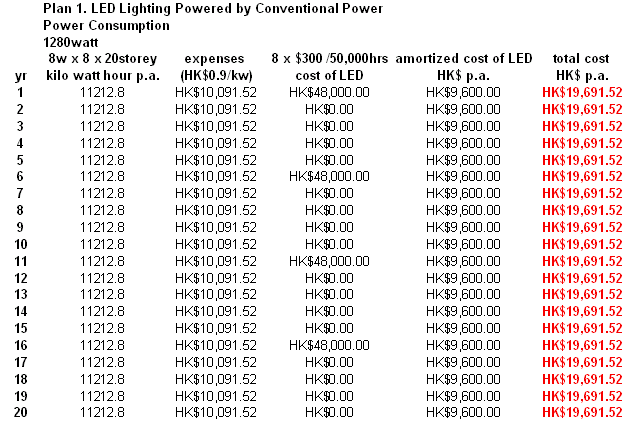
To everybody's surprise, the saving of money is
incredibly huge. The cost of LED lamp can be paid back in the first year and
remarkable sum of money can be saved in the following 4 years. There are two
possible explanations to this scenario: In the first place, people tend to stick to their habit, and secondly, they are not certain about the
merit of the new lighting device. Obviously, it is a matter of habit, knowledge
and confidence.
To find out the cost efficiency of solar
energy, I did one more analysis. Assuming that the LED lighting devices are
powered by Solar Panels installed on the roof top or open podium of the
building. A capital investment will be accrued for the installation of the
solar power supply unit including the solar power panel, wiring network, power
inverter and energy storage system. Most of the solar panel in the market are
claimed to have a service life of more than 20 years. A simple straight line
method is applied for the calculating the amortized cost of the solar panel and
the others. From internet, I sourced the prices of the system components of the
solar power supply unit. They are summarized in the table 3:
Table 3. Cost of Solar Power Supply Unit (with
Energy Storage System Lasting for 12 Hours)
|
System
Components |
Specification |
Unit Cost |
Sub-Ttl Cost |
Sub-Ttl Cost
p.a. |
|
Kyocera solar panel : Qty: 16pcs 1 |
Model: KD210GX-LP Power:210 watt , Voltage: 26.6volt,
Amps: 7.9A Weight: 40.8lbs, Dimension: 1.5m x
1m, Service life: 20
years |
US$762 (HK$5944) |
HK$95,104/20yrs |
HK$4755.2 |
|
Power Inverter 2
Qty: 1 unit |
Victron Phoenix 24V 5000VA 230V Sinewave Inverter,
Parallelable Phoenix 24V 5000VA Service Life: not
specified, usually very long |
£2037 (HK$28518) |
HK$28,518/20yrs |
HK$1425.9 |
|
Energy Storage System (ESS) – about 20kwh Capacity: 8w x 8 x 20storey
x 12hrs =15.36kwh |
20kwh auto-switched rechargeable battery system, (note: at present
lead-acid rechargeable battery is the cheapest among all and the service life
is 10 years) |
US$200/kwh |
HK$31,200/10yrs |
HK$3,120 |
|
Wiring & Panel Installation (30 sq m) |
From roof top or podium to the switching room,
service life: more than 20 years (As the power
consumption is small and network is simple, the cost is expected to be very
low) |
|
HK$10,000 |
HK$500 |
|
|
|
|
Total Cost p.a. |
HK$9801.1p.a. |
Base on the cost information, I worked out the
table 4. It shows the cost of using LED lighting devices powered by solar
panel. It is clear that the solar energy is not so “cheap” as what people
think. Even the price of solar panel have dropped a lot but the ESS (energy
storage system) is still accounting for a significant portion of the capital
investment for the solar power supply unit. The cost for electric power storage
is about US$200 per kilo watt hour in the market. As the lead-acid rechargeable
battery is still the cheapest power storage among all others, I had no choice
but assume the use of it as the core of the ESS. A 20kwh auto-switched
rechargeable battery system will be used for supplying the power to the 160 LED
lamps in the night time for about 12 hours. However, new batteries using
cleaner and more cost effective new storage technology are expected to be
delivered to the market from time to time, pushing the price down at a faster
speed in the coming years. Therefore, the calculation as shown in the table is
just a conservative projection of the cost. There is a good chance for
attaining a further reduction in the energy storage cost.
1. http://www.wholesalesolar.com/products.folder/module-folder/kyocera/KD210GX-LP.html
2.
http://www.cclcomponents.com/product.asp?ID=1766
Table 4 Cost Analysis for Using LED (Light Emitting Diode) Powered by Solar
Energy over a Period of 20 Years
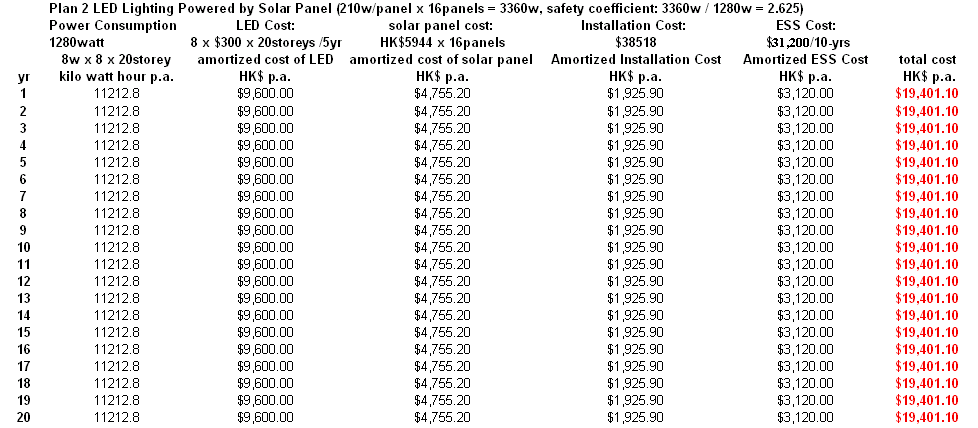
Though the cost efficiency enhancement is
relatively smaller than the efficiency gain from the replacement of
conventional lighting device with LED lamp, somehow it will further reduce the
cost from HK$19691.52p.a. to
HK$19401.1p.a.. All the data in the above analysis have convinced us that the
use of LOW power lighting devices powered by solar energy is justified in terms
of the immense benefit to the consumers, even excluding the external positive
effect of the change to environment and society as a whole. Yet the public
response to the appeal to the use of such devices and solar energy is sluggish.
As what I point out before, people refuse to make the move because they stick
to their habit on the one hand and can not be sure if the money they pay for
the expensive device at the beginning will be paid back at the end or not on
the other hand. The technical knowhow involved in the switch to the new devices
also bother the public a lot in taking real action to embrace the new fashion
of green life. The suppliers of these low power lighting device and solar power
supply unit sell their products in the market like all traditional merchants,
which means that the customer must take the active role to make the change.
Therefore, I must work out a totally different
mode of business so that all the customers will be convinced by us that the
change will give them incredible benefit immediately. The following
considerations are taken in forming the action plan:
- Focusing on the Replacement of
Low Power Consumption Application: As the cost of ESS is still high
and solar energy is not suitable for supplying energy to high power
consumption electric appliance, the solution is suitable for low power
consumption application only.
- Ability to Create Shocking Effect: The contrast between the
financial situations before and after implementation of the energy saving
plan must be great enough to shock the consumer and the general public.
The success of the project in a housing estate will attract more consumers
to join the program voluntarily. Therefore, the older housing estate using
traditional lighting device like tungsten lamp are ranked as the best
target customers. Moreover, the principle and techniques of actuary will
be employed to make the fee scheme more attractive to the customers.
- Relatively Simpler Physical Environment: The modification of the
power supply network may cost a lot of unnecessary money. Hence, the
lighting device in the public area is considered as the most suitable
target for the replacement. A minor modification in the switching room
will work for the whole building.
At last, to make
the proposal an irresistible offer, the project will pay the customer the
benefit in advance upon the signing of the contract. The solar energy firm will
bear all the capital and operational cost in the whole process. The consumer
will enjoy the benefit immediately without paying anything. According to the
projection as shown in the following table, all the capital investment will be
paid back in three years and the project will keep generating profit in the
next 15 years or more. In the first five years, the consumer's electric bill
will decrease by $50,457p.a. while the profit from the project will be
HK$57,642.20p.a. in the first 5 years . The internal rate of return of the
project with respect to the initial capital investment of HK$212, 822 will be 27.07614%.
This project is a win-win solution to everybody in Hong Kong.
From the historical
data of the past few decades, I have reason to believe that the price of
electric power generated by burning fossil fuels will be increasing but the prices of solar panel and
ESS will keep falling down. The profit will be even higher than estimated.
There is no cost for the customers except the permission for the occupation of
the useless roof top for the accommodation of the solar panel and no risk of
any kind exposed in the implementation of the project. They can get the return
at the beginning and are free from any trouble in setting up the power unit. In
such a situation, they have no reason to reject the offer.
Table 5 Cost and Benefit Analysis for the Application of Plan 2 under
the Situation of Case 2
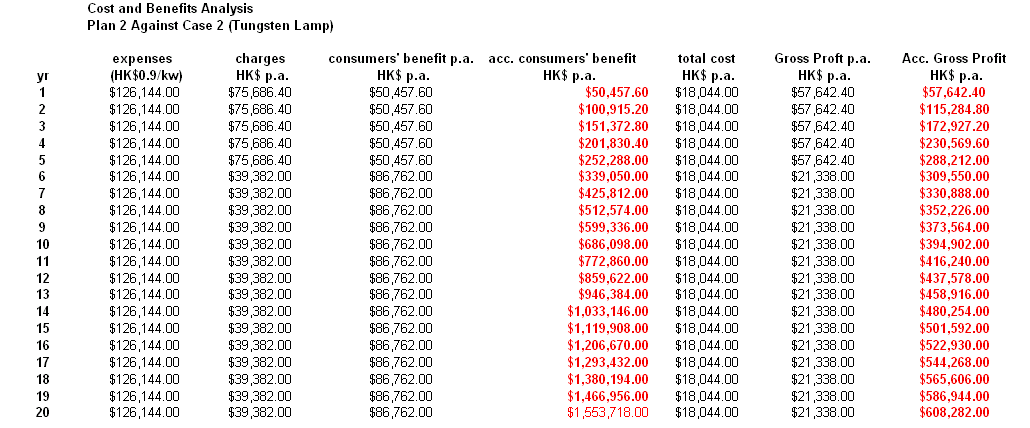
Solar energy will not increase the temperature of the earth as it is already there. The solar power supply unit only convert it into a form that is usable to human being. Heat and carbon dioxide emission will be reduced. All we need is just a little bit innovation and creativity for the initialization of the shift from a traditional mode of power consumption to a new one.
